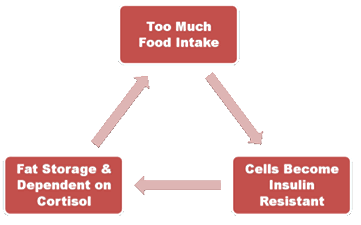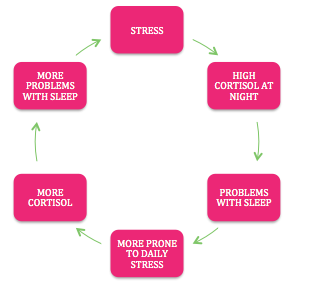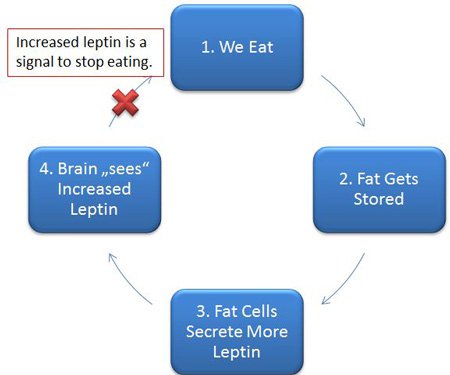Weight Loss is Harder For Women | Part 2
Weight Loss Key Points:
- Women have less muscle mass and burn less calories than men on a daily basis.
- Women metabolize foods differently through the month based on hormone fluctuation, often leading to more stored subcutaneous fat.
- Horomen imbalances such as high estrogen, progesterone deficiency, high cortisol, insulin resistance, among other fluctuations make weight gain and weight loss resistance more likely
- Training around your menstrual cycle is vital.
- Getting enough sleep along with higher protein diets, weight training, and lower carb diets might be optimal for female weight loss


America is at an all-time high for obesity prevalence and women are more likely to be in the extremely obese category even though weight loss is usually a top priority.
In multiple studies measuring caloric deficit and NEAT, or non exercise thermogenesis which is just normal activity levels throughout the day ( think about that one kid who can’t hold still— thats NEAT), women tend to have lower NEAT levels when over eating compared to guys whose NEAT level often increases.


Women’s bodies fight fat loss far more than men on basically every level. Their appetite increases to a greater degree, their metabolisms adjust downwards either more, more quickly or frequently both. Not to mention massive water retention that can mask fat loss for weeks on end due to both psychological and physiological reasons.
Energy Usage
Women’s bodies tend to burn less calories overall compared to men, sparing subcutaneous fat.[define]
After a meal, a man will burn some amount of fat from the meal off while women’s bodies prefer to use carbohydrate and store the fat in fat cells. Worse yet, that fat tends to preferentially be stored in the lower body, blood flow to the area, which is normally low increases after a meal. The old saying may be true “A moment on the lips, a lifetime on the hips.”

Men also tend to store more fat calories in something called visceral fat (fat around the gut) and this is more easily burned off for fuel even though It also predisposes men towards heart attacks. Women, who store more fat subcutaneously (under the skin) are protected from heart disease until after menopause . But subcutaneous fat is harder to get rid of—that’s the drawback.
When reduced to the same calorie diet, women always lose less total weight and less fat than men and there are a few reasons for this.
One is that women are typically smaller and that means that they usually can’t create as large of a deficit on a diet. “Even on the same number of calories (say 1500/day), a woman with a 2000 per day caloric expenditure is only on a 500 calorie/day deficit while a man with 3000 calorie per day expenditure is on a 1500 calorie per day deficit. The man loses faster and more” Explains Lyle McDonald, Phd & leading nutrition researcher.
Women do not have as much muscle mass as men, reducing the total amount of calories they burn per day.
Important Weight Loss Hormones
There are hundreds of hormones at work during the different phases of a woman’s life and in her menstruation cycle. I wanted to breakdown a few of the main hormones to help understand how the menstruation cycle affects fat loss related to hormone circulation.
This is a VERY BASIC break down of what these hormones do related to body composition:
Insulin: inhibits the breakdown of fat cells and stimulates the creation of body fat.
Testosterone: Builds muscle increases libido, can negate effects of estrogen
Progesterone: Helps with metabolism, thyroid, and insulin management
Estrogen: Female sex hormone often causes fat storage if too high
Cortisol: Stress hormone leading to fat storage
DHEA: precursor to all of your major sex hormones and energy
HGH: Tissue repair, energy, and metabolism
Insulin: Fat storage hormone; resistance cause weight gain
Leptin: Hunger hormone
Thyroid: Regulates metabolism, weight loss resistance if low
Menstrual Cycle and Dieting
The menstrual cycle, the variation in hormones which occurs every month, complicates the entire fat loss process for women.
Many aspects of female physiology from appetite, whether they burn primarily carbohydrates or fats for energy, energy expenditure, even coordination can change at different parts of the cycle and ignoring this when describing diet or exercise programs is a mistake. Yet that’s exactly what most programs do.
No discussion of female fat loss can take place without understanding the normal female menstrual cycle.


The first day of bleeding for a woman represents day 1 of the menstrual cycle. The menstrual cycle can then be divided into two phases, the follicular phase (named for the maturing of the ovarian follicle) and the luteal phase (named for the corpeus luteum which ovarian follicles become after ovulation). Ovulation, the release of an egg from the ovaries, separates these two parts of the cycle.
The follicular phase is associated with higher estrogen levels compared to progesterone, while the luteal phase is the reverse. The relative ratios of these two hormones can have an impact on female related fat loss and health.
A key fat loss measure in women is the estrogen and progesterone balance and how those hormones interact with other hormones like cortisol or insulin.
Just as looking at the girth of a man’s belly can tell you a little about his testosterone levels, bigger hips and thighs on a women suggest greater estrogen levels relative to progesterone. The reverse of that, larger breasts and smaller hips and thighs, MAY indicate the opposite balance of these hormones.
The menstrual cycle is another key indicator of hormone balance. Since the time just before menses is usually a progesterone dominant time, PMS is a strong indication there is a progesterone deficiency relative to estrogen.
Don’t get confused here between a relative deficiency and an absolute deficiency. A woman can have higher than normal progesterone levels but still have a relative deficiency if estrogen levels are much higher in comparison.

Many women with low progesterone relative to estrogen will report feeling like a completely different person before ovulation (the first two weeks of cycle) vs. after ovulation (last two weeks of cycle), where they feel much worse. This ill feeling usually manifests as depression, breast tenderness, moodiness, fatigue, lack of motivation, bloating, and other complaints.
Female Fat Distributions
Progesterone & estrogen both play a role in keeping the waist of women smaller. This is because estrogen works against the action of insulin (and testosterone is a belly fat storing hormone in women) while both estrogen and progesterone oppose the action of cortisol.

Insulin and cortisol (with testosterone and low estrogen) are implicated in belly fat deposition in women. Estrogen is the biggest factor in increasing fat storage at the hips and thighs providing the hour-glass shape. Progesterone with estrogen halts the storage of fat around the waist, but stress can have more of a negative impact on progesterone’s action. High stress has been shown to negatively impact progesterone, so a women who sees fat accumulating around the waist may want to work to reduce stress and raise progesterone.
Interestingly, progesterone can be used to make cortisol in the adrenal glands. Many physicians believe progesterone derived from the ovaries can be used to increase cortisol production when needed. This is called “progesterone steal” and it is used to describe a situation where the adrenal glands “steal” or “use up” progesterone to make the stress hormone cortisol. This likely only becomes an issue at menopause.

At the same time, just as progesterone interrupts the action of cortisol, cortisol does the same thing to progesterone making stress especially insidious for women. It reduces production of DHEA, testosterone, and estrogen production while increasing cortisol production and lowering progesterone itself, resulting in lower ability to oxidize fat among other health problems.
Estrogen is a little different. Estrogen works to increase fat storage by up-regulating what is known as alpha-adrenergic receptors in female fat depots around the hips and thighs. Adrenergic receptors are like the gas and brake peddles on your car and work to accelerate or decrease fat usage.
Beta-adrenergic receptors increase fat burning while alpha adrenergic receptors block it. The hips and thighs of a woman have higher amounts of alpha adrenergic receptors compared to men. This is also the major reason it is so difficult for some women to lose fat from the hips and thighs.
Many women have plenty of fat to spare in the hips and thighs but instead of burning it, they will become smaller in the torso and breast first and remain bigger on the bottom. This is a very frustrating scenario for many.
Estrogen increases alpha-adrenergic receptor numbers while progesterone decreases it. Progesterone, like testosterone in men, MAY increase beta-adrenergic receptors. In this way, estrogen and progesterone work to influence the ability to burn fat and determine from which areas it will be taken from. Where body fat is stored or burned in most women is usually an issue of hormone balance not calories.
Female Hormone Changes: Age, Lifestyle, and the Environment
Women are often duped into believing the low calorie diet and aerobic exercise myth. This approach to weight loss rarely works and often creates damage to their body as a result. As a woman ages, and as a consequence of stress, or because of environmental estrogen mimicking compounds several things begin to occur. The ovaries decrease their production of estrogen and progesterone. This exacerbates estrogen and progesterone imbalance, further pushing the body more towards estrogen dominance.
There are also many estrogen mimickers in our food and environment. At the same time, fat cells continue to produce estrogen through an enzyme called aromatase present in fat cells. This also leads the estrogen/progesterone balance to shift more towards estrogen. At the same time slimming and muscle building hormones like human growth hormone (HGH) and DHEA, decline. Together this creates the perfect storm for female related fat gain and most of it occurs in the mid-section.
DHEA, HGH and progesterone are all hormones that act to keep a woman lean and block the storage of fat in the middle of her body. The tricky part is that a low calorie diet and a focus on aerobic exercise makes this worse because they do nothing to restore these powerful hormones and may actually worsen the estrogen progesterone imbalance in the long run.
Fixing the Problem:
Women should be focused on eating more of the right things, exercising smarter, and resting enough. This means eating higher amounts of vegetables and protein as well as engaging in weight training over cardio. I discuss a very good approach for fat loss in my ebook “The Art of Losing Body Fat” so if you haven’t read that yet, go get a copy!
There are only three ways to reliably restore HGH in the body:
3. intense weight training
Weight training is perhaps the most important aspect of this and is critical for female health especially to stop the belly fat that accumulates during aging. HGH is to women what testosterone is to men. It keeps them looking young, lean, and firm. Once progesterone levels fall due to stress, menopause, or other factors, HGH is all that is left to keep belly fat in check.
If you are a women looking to optimize your hormones with exercise then weight training needs to be your focus along with more relaxing activities like lots of slow leisurely walking.
Training with the Menstrual Cycle:
Interestingly, the menstrual cycle may provide unique opportunities for women with exercise. Estrogen increases the amount of fat burned during exercise, but makes sugar burning less efficient. Progesterone opposes the action of estrogen. Since lower intensity exercise burns more relative amounts of fat and higher intensity is fueled more by sugar burning, women can cycle their training modalities to work with these fluctuations.
It is important to understand estrogen and progesterone action on fat burning is completely wiped out by the influence of stronger hormones like insulin. So, in order for a woman to reap any benefits from this type of cycled training, the insulin exposure will need to be low.




And remember, it is never wise to take off-the-shelf advice like this and assume it will work for every women. You are unique and must become like a metabolic detective to ultimately adjust the approach to fit you.
More long duration and slower type exercises (walking, biking, running, etc.) may be of more benefit during the estrogen dominant follicular phase. Higher intensity shorter duration activities (sprint training, HIIT, etc) may be able to generate more of an EPOC after-burn effect during the progesterone dominated luteal phase. But during the luteal phase you should be more focused on relaxing and restorative activities. Weight training has benefits across the board in opposing the action of stress hormones and assuring plenty of HGH.
Many women are progesterone deficient and have heavy estrogen dominant menstrual cycles coupled with PMS for several weeks when their estrogen is not balanced with enough progesterone. Aside from weight gain caused by estrogen dominance, the low progesterone encourages weight gain as progesterone supports thyroid while increasing body temperature and metabolism.
Leptin & Weight Loss
Leptin is a hormone that is produced by the fat cells in the body. Its main role is regulating how many calories we eat and burn, as well as how much fat we carry on our bodies. When we eat, leptin is supposed to signal to the brain that we are full. Generally speaking, the more body fat you have, the more leptin you have circulating.


However… the problem is that the leptin signal isn’t working. This is an example of leptin resistance. There’s a whole ton of leptin floating around, but the brain doesn’t “see” that it is there (11). Being resistant to this hormone’s effects is now believed to be the leading driver of fat gain in humans (2) and the main biological abnormality in human obesity (12).
Interestingly, gender also plays a role in leptin levels, as women demonstrate markedly higher levels, compared to men (5) In one study, gender differences in the relationship between leptin & insulin resistance showed “Insulin resistance and SNS activity appear to be linked and Leptin appears to exert a greater effect on the SNS in women, possibly because of their greater fat mass.” possibly inferring that women are more likely to have higher leptin levels and higher insulin resistance than men, contributing to weight gain or “weight loss resistance”.
When the brain doesn’t receive the leptin signal, it erroneously thinks that the body is starving, even though it has more than enough energy stored.
Low carb diets along with cutting out refined food as I discussed in my previous article Why We Are Getting Fat may help women who are insulin resistant and find themselves constantly craving food.
Another big problem women face is dieting for too long and too severe. Dieting is stressful and can really affect your ability to lose weight. Long diets are often associated with the fall in leptin. metabolic rate falling, decreasing T3 levels, increasing cortisol, and increasing appetite are all seen on long diets.
Taking diet breaks every few weeks will help ensure long term success from both a psychological and physiological perspective.
Birth Control & Weight Loss
Study after study has examined the relationship between today’s most popular forms of hormonal contraception and weight gain. The vast majority of these studies have found no reasonable evidence to support the claim. Any weight gain that may occur in the first weeks or months after beginning birth control is typically due to water retention. It isn’t actual fat gain.
While there are several forms of birth control with different mechanisms of action, I will not be going that in depth into each off them but leading researcher Lyle McDonald will be so follow his updates on his site.
Sleep & Weight Loss
Sleep duration has a major impact on leptin levels as well as on cardiac sympathovagal balance, cortisol, TSH, and carbohydrate metabolism.
One study has claimed that 46% of women are sleep deprived.
Being a woman undoubtedly makes sleep difficult, from menstrual cramps, to emotions running wild, to motherly instincts to take care of those around you. It is vital for women who want to lose weight to get enough sleep.
Summing it up
In humans, sex-specific specialization is associated with distinct body-fat distribution and energy utilization patterns; i.e., females store more lipids and have higher whole-body insulin sensitivity than males, while males tend to oxidize more lipids than females. These patterns are influenced by the menstrual phase in females, and by nutritional status and exercise intensity in both sexes. Women tend to store, whereas men tend to oxidize, circulating free fatty acids.
Women can still lose body fat given they follow a protocol that allows for the right amount of calories and macros based on their TDEE but it just won’t be as easy as it is for men. There will be more plateaus and it might take longer but it is still possible!
-
Women burn less calories than mean due to less muscle mass, lower neat, and less overall mass
-
Different phases of women’s menstrual cycle provide different opportunities to burn fat
-
a moderate to low carb approach with diet breaks might be optimal for fat loss for women who show signs of leptin/insulin resistance
-
DHEA, HGH and progesterone are all hormones that act to keep a woman lean and block the storage of fat in the middle of her body
-
Weight training and higher protein diet are optimal for women to lose body fat while maintaining lower intensity exercise regularly like walking
-
While estrogen, progesterone, cortisol, leptin and insulin play major roles in women’s ability to lose fat, total caloric intake needs to be accounted for.
Edit: I didn’t even get around to discussing the different stages of a women including puberty, pregnancy, pre & post menopause so look out for a potential part 3 coming!
References:
Eat Behav. 2008 Apr;9(2):170-80. doi: 10.1016/j.eatbeh.2007.07.005. Epub 2007 Aug 3.
Front Endocrinol (Lausanne). 2015 Jan 19;5:241. doi: 10.3389/fendo.2014.00241. eCollection 2014.
Psychoneuroendocrinology. 2016 Jun;68:39-46. doi: 10.1016/j.psyneuen.2016.02.023. Epub 2016 Feb 26.
Uranga AP, Levine J, Jensen M.. Isotope tracer measures of meal fatty acid metabolism: reproducibility and effects of the menstrual cycle. Am J Physiol Endocrinol Metab (2005) 288:E547–55.10.1152/ajpendo.00340.2004 [PubMed] [Cross Ref]

